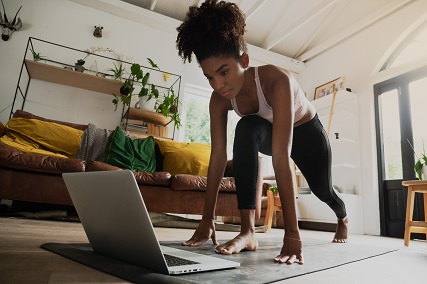
Fall 2020
Yoga Practice in the Time of COVID-19: Perspectives from Two Expert Researchers
Lucy Finkelstein-Fox, MS✉; Integrative Health and Spirituality SIG

The COVID-19 pandemic has made an immeasurable impact on the daily lives of clinicians, researchers, and the populations they serve. Over the past several months, members of the (newly merged) Integrative Health and Spirituality SIG have found creative ways to leverage technology as a means to safely deliver yoga and other mind-body interventions to a range of populations.
Yoga is a mind-body practice incorporating aspects of meditative movement, breathing, and spirituality. Based on the recent experiences shared by experts Crystal Park, PhD, Professor of Psychology at the University of Connecticut, and Lisa Uebelacker, PhD, Professor of Psychiatry and Human Behavior at the Alpert Medical School of Brown University and Assistant Director of Psychosocial Research at Butler Hospital, we provide several considerations for the practice of yoga during the COVID-19 pandemic below.
- Minimize Risk. Depending on the characteristics of participants, different methodological adaptations may be necessary to minimize the risk of yoga. For example, Dr. Uebelacker notes that it is important for participants at elevated risk for COVID-19, including those of older age, to stay home and receive clinical services via video. For participants with physical limitations that might necessitate live instructor modifications to prevent injury (e.g., low back pain), Dr. Park describes that she and her team have considered adapting interventions to be delivered in large, socially-distanced spaces (e.g., an open gymnasium) and plan to be flexible as public health recommendations evolve over the coming months.
- Promote Social Connection. Video platforms such as Zoom and WebEx are now commonly used by healthcare practices as well as commercial yoga and fitness studios, making them familiar to many participants in yoga interventions. However, web-based delivery may make it difficult for intervention participants to establish informal social relationships, which Dr. Park notes are “a big part of people’s experience in any intervention.” To enhance perceptions of social connection in an online yoga study, Dr. Uebelacker and her team have scheduled time for intervention participants to virtually meet one-to-one with their yoga instructor at the start of the program.
- Create a Peaceful Environment. Dr. Park and her collaborators have been working hard to make remote yoga “feel like something special.” Whereas studios are typically decorated with special textiles, meditation cushions, or spiritual images that orient practitioners to the sacred space, many people are now practicing yoga in spaces they also use for work or other activities (e.g., bedroom). To enhance separation between space used for yoga and other activities, practitioners may consider making small changes to their environment like lighting candles or playing music.
Despite the new challenges presented by COVID-19, these changes may also pave the way for positive developments in yoga practice, reducing many traditional barriers to access (e.g., transportation, cost, scheduling). Dr. Park anticipates that the shift to remote yoga practice may help participants to cultivate the “inward focus” emphasized in yoga philosophy. In one of Dr. Uebelacker’s recent interventions, the researchers similarly speculated that teenaged participants might feel less self-conscious when practicing at home.
Yoga, meditation, and other integrative and spiritual practices may be useful resources for tolerating the uncertainty of COVID-19. Dr. Uebelacker describes the benefit of focusing on the here and now: "Practicing being in-person, in the moment, is a good reminder that we only need to get through this moment, and shifts attention away from questions like ‘how long is this going to last?” She also notes that another benefit of yoga practice comes from physical poses, or asanas, which may counteract the deleterious effects of sedentary behavior that has increased as individuals work from home.
Finally, Dr. Uebelacker also encourages those interested in remote yoga practice to look into yoga opportunities nearby. “Check out your local yoga studio to see what they are offering virtually. It can be nice to do ‘live’ yoga – even if you are in your own home. If you do live virtual classes, be sure to pay for them.”
SBM members interested in online yoga may also consider the following resources:
- - Mindfulness Center at Brown University: https://www.brown.edu/public-health/mindfulness/home
- - Kripalu Center for Yoga and Health: https://kripalu.org/
- -Yoga Journal: https://www.yogajournal.com/
- -Yoga with Adriene: https://yogawithadriene.com/
Interested in joining the Integrative Health and Spirituality SIG? Visit the SIG webpage to learn more and add the IHS SIG to your SBM member profile to stay up to date.
Let’s discuss your thoughts about this article on Twitter with our new hashtag #IntegrativeSBM!